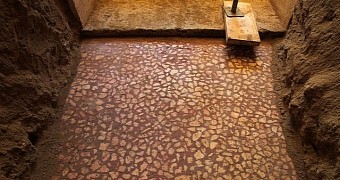There's a lot of commotion going on at an archaeological site in Greece these days. Thus, researchers are busy excavating an Alexander the Great-era tomb, and are unearthing stunning artworks every day.
The tomb in question is located in Amphipolis, a municipality in Greece's Serres regional unit. It is encircled by a massive 1,600-foot (500-meter) wall made of marble, and has not yet been explored in its entirety.
Information shared with the public says that the entrance to this ancient tomb is guarded by two lion sculptures. This opening leads to an antechamber, which in turn guides visitors to the actual tomb, Live Science informs.
It is in this antechamber that archaeologists found a stunning mosaic that, like the tomb, dates back to the 4th century BC. The mosaic covers the antechamber's floor, and researchers say that, given its age, it is in excellent condition.
A photo of this mosaic was released to the press by the Greek Ministry of Culture, and is available next to this article. As easily noticeable, the mosaic comprises bits and pieces of white marble fitted onto a red background.
The white marble fragments are irregular and were placed on the ground far enough from one another so as to make sure that the red background would remain visible. Otherwise put, somebody gave this mosaic a lot of thought before actually creating it.
Dye traces indicate that, when built, the antechamber accommodating for this floor mosaic was painted in black and red. The wall behind the two lion figures guarding the entrance to the tomb, on the other hand, appears to have once been adorned with a blue fresco.
As detailed by the researchers now exploring this tomb, the archaeological site accommodating for this ancient construction is dubbed Kasta Hill. This is yet to be confirmed, but specialists suspect that the structure was erected by Alexander's chief architect, a man named Dinocrates.
Since excavation work first began at this site until present day, archaeologists have failed to uncover any graves. However, since the tomb is yet to reveal all its secrets, researchers have not lost hope that they might find not just artwork, but also human remains at this location.
To make sure that the tomb will not be damaged by the elements while scientists are busy studying it, a drainage ditch was placed next to the entrance to this structure. Together with other infrastructure, this ditch is expected to help make sure that no rainwater works its way into the monument.

 14 DAY TRIAL //
14 DAY TRIAL //